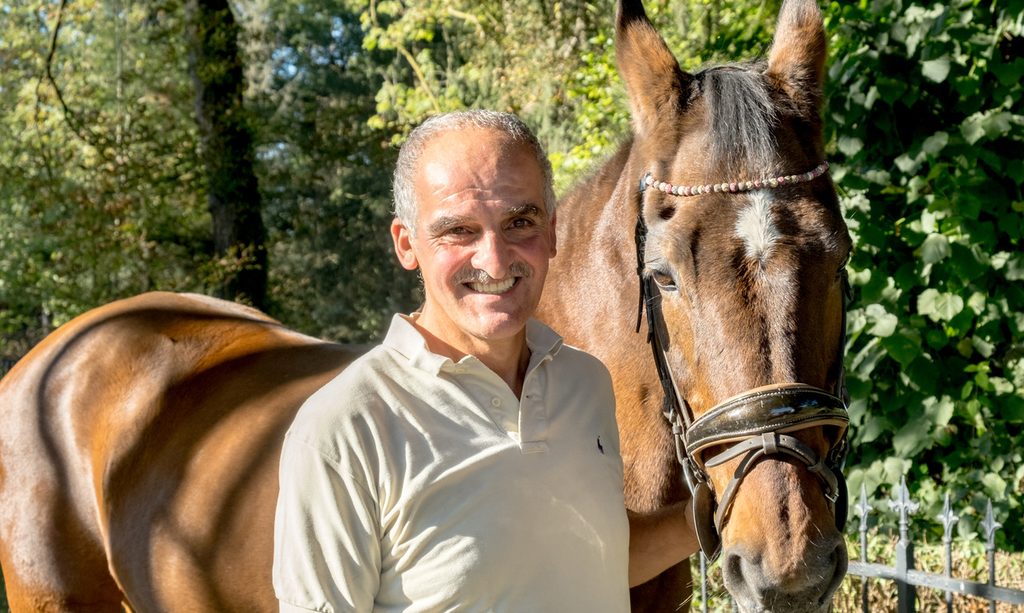Equestrian centre
Trail Course
Navigating tree trunks and other wooden obstacles; balancing over bridges and seesaws; climbing steps and hills; exploring water holes:
the sort of obstacles that you and your horse would only encounter in the wild on long trail rides can be experienced every day in compact form on our trail course at Nettehammer.
On our trail course at Nettehammer, on the edge of the Vulkaneifel district, we welcome horses of all breeds and ages, as well as all riding and working styles: from Mini Shetty to Shire Horse, English to Western, gaited to hunt riding. The diverse obstacles in our Extreme Trail ensure that every team will find their perfect training conditions here.
Riding our trail course is not a race; rather, it is essential that you form a close unit of trust with your horse, resting upon finely attuned communication. The horse explores the obstacles on its own initiative and at its own pace - by probing with its hoof or sniffing. During this training, the horse builds its trust, both in itself and in humans: an important lesson for the mutual relationship and for subsequent training!
We recommend starting our trail course with ground work, where the horse can find the best way for itself on the lead rope with plenty of headroom. Sensitive guidance is always necessary here, for example to shift the fore- or hindquarters or to direct the horse sideways or backwards. Allow yourself plenty of time.
If the horse can overcome the obstacles safely, calmly and at a steady pace during ground work, nothing stands in the way of riding the trail. Loose reins allow the horse the necessary headroom. Depending on the obstacle, only light body weight pressure or thigh pressure is required.

Our trail course offers both horse and rider many positive training outcomes, including the following:
Your horse
- builds and stretches deep muscles in a targeted way;
- develops balance, precision, steadiness and rideability;
- improves concentration skills and ability to think for itself;
- learns to remain composed and calm in challenging situations;
- strengthens self-confidence and obedience;
- develops safe responses, even over rough terrain
Rider and animal
- consolidate or learn good communication;
- build mutual trust and sensitivity;
- improve cooperation;
- strengthen their partnership for all situations, also transferable outside the trail area;
- experience a playful approach to various challenges;
- enjoy a varied balance to their daily training
Use of the trail area is free of charge for our riders. Malu Abbink from Equipsych offers various trail courses for external riders: https://www.equipsych.de/trailkurs/.
You can also book seat training courses with her: https://www.equipsych.de/sitzschulunglehrgang/


Balance Beam
Concentration-Timing-Communication
On the balance beam, horse and rider are challenged both physically in terms of balance, and mentally in both concentration and timing. This develops fine-tuned communication and cooperation. Small variations increase the difficulty of this wooden walkway, which serves as ideal preparation for the seesaw and suspension bridge.

Water Obstacale
Composure-Trust-Control
The water hole offers a variety of training opportunities - from composure training while crossing the stream to distance work in the cool water. This is an ideal spot for work on the long lead rope, as well as for building up mutual trust - including from the footbridge. In summer, the stream is simply a lovely place for a refreshing break.

Gangplank
Concentration-Teamwork-Balance
The narrow wooden footbridge above the water hole trains horse and rider: both physically in balance, and mentally in concentration and teamwork. The challenge of the footbridge is similar to that of the balance beam, but its greater height means that good shoulder control is particularly important, to prevent the horse from pushing or jumping.

See-Saw
Deep Muscle – Desensitisation - Balance
Horses approach the seesaw in very different ways. It is important that the rider take their time to guide the animal calmly over the obstacle. The seesaw demands courage and trust, strengthens deep muscles, and desensitises the horse to sounds as well as swaying surfaces. This prepares the horse for loading in a horse trailer, for example.

L-Bend
Distance work-Dexterity-Permeability
With its tight 90° turn, the L-bend challenges both horse and rider. In order for the horse to coordinate the backward turn, the rider must gently direct both its shoulders and hindquarters from an outside position. This is an ideal exercise for distance work as well as developing the horse's dexterity. In ground work, this obstacle is more difficult than when ridden.

Timber Range
Concentration-Surefootedness-Load-bearing
Many paths lead to the goal, but every step must be well thought out. In the Mikado, the horse has to concentrate hard in order to aim and place its hooves between the trunks. If the horse calmly finds its own way through with its head down, the first goal in the Mikado has been reached. This promotes surefootedness and load-bearing for healthy, coordinated movement.

Suspension Bridge
Deep muscles – Balance - Composure
Walking calmly over wobbly surfaces is not the only training outcome of the suspension bridge. Horse and rider should first work their way straight across the obstacle and then gradually incorporate further exercises. Please do not use the suspension bridge for beginner training: horses should be experienced and well-practised on wobbly surfaces. Mastery of the balance beam and seesaw are important prerequisites for this obstacle.

Logs
Load-bearing -Coordination-Surefootedness
Slowly passing over the tree trunks, the horse learns to trust its own surefootedness and improves leg coordination. Balancing and developing load-bearing over the logs is a particularly helpful exercise for younger horses. The tree trunks are ideal for warm-ups.

Curtain
Serenity-Trust-Cooperation
Natural materials form a curtain that offers an integral aspect of composure training: the goal is for the horse to be ridden or led through the curtain without stress. Through relaxed body language, composure and time, the human supports the horse in calmly walking through the curtain and perceiving this not as stress but as an exciting challenge.

Tree Stumps
Communication – Agility - Suppleness
Five equally-spaced tree stumps are used for slalom training - on lead rope or ridden - as well as for lunging at different lengths. The human guides the horse at a distance with precise aids, requiring clear communication. Positive training outcomes include flexibility, agility, balance and coordination.

Gate
Throughness-Rideability-Obedience
A trail course classic: on horseback, the rider opens the gate, rides through it and closes it behind him. Both rider and horse must concentrate and work precisely. The rider uses finely-tuned prompts to control the hindquarters in particular. While the rider improves one-handed rein control, the horse develops concentration, rideability and obedience.

Hill
Strength building - Control – Fine Prompts
Training on the hill works out the horse's muscles and promotes strength-building during controlled climbs up and down. The hill also lends itself well to practising stopping on command. To increase the level of difficulty, simply vary the pace or practise turning on the hill. Be sure to take plenty of breaks to rest and reward the horse.






